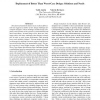Free Online Productivity Tools
i2Speak
i2Symbol
i2OCR
iTex2Img
iWeb2Print
iWeb2Shot
i2Type
iPdf2Split
iPdf2Merge
i2Bopomofo
i2Arabic
i2Style
i2Image
i2PDF
iLatex2Rtf
Sci2ools
87
Voted
ICCD
2005
IEEE
2005
IEEE
Deployment of Better Than Worst-Case Design: Solutions and Needs
The advent of nanometer feature sizes in silicon fabrication has triggered a number of new design challenges for computer designers. These challenges include design complexity and operation in the presence of environmental and device uncertainty. To make things worse, these new challenges add to the many challenges that designers already face in order to scale system performance while meeting power and reliability budgets. Current design objectives are being met by applying even more engineers and increasing overall design times, an unsustainable trend. This paper overviews a novel design strategy, called Better Than Worst-Case design, that addresses these challenges through a methodology based on separating the concerns of performance and reliability by coupling complex design components with simple reliable checker mechanisms. We present the key aspects of Better Than Worst-Case Design and cover some recently proposed solutions that deploy this technique in application domains rangi...
Related Content
| Added | 16 Mar 2010 |
| Updated | 16 Mar 2010 |
| Type | Conference |
| Year | 2005 |
| Where | ICCD |
| Authors | Todd M. Austin, Valeria Bertacco |
Comments (0)

